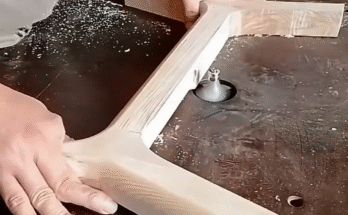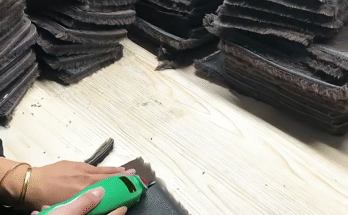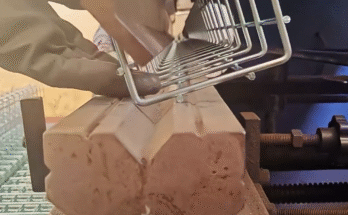Installing wooden flooring, whether solid hardwood, engineered wood, or laminate, is a transformative home improvement project that adds warmth, elegance, and value to any space. While the broad expanse of the floor often gets the most attention, the true mark of a professional and durable installation lies in the meticulous attention paid to the edges. The cutting process for wooden floor edges is critical, dictating not only the aesthetic finish but also the structural integrity and longevity of the entire floor. This guide will delve into the various aspects of this precise task, from understanding expansion gaps and choosing the right tools to executing accurate cuts and finishing the edges flawlessly.
Understanding the Necessity of Edge Cutting
Wooden flooring, being a natural or wood-based product, is inherently hygroscopic, meaning it absorbs and releases moisture from its environment. This characteristic leads to a phenomenon known as expansion and contraction. When humidity is high, wood absorbs moisture and expands; when humidity is low, it releases moisture and contracts. Ignoring this natural movement is a common mistake that can lead to significant problems:
Buckling and Cupping: Without adequate space to expand, the floorboards will push against walls or fixed objects, causing them to buckle upwards or cup downwards, creating uneven and unsightly surfaces. Gapping: Conversely, insufficient humidity can lead to excessive contraction, resulting in unsightly gaps between floorboards. Structural Damage: In extreme cases, the force of expanding wood can damage baseboards, drywall, or even structural elements of the building.
This is where the concept of the expansion gap becomes paramount. An expansion gap is a deliberate space left between the edges of the installed flooring and any vertical obstruction, such as walls, doorframes, cabinets, or pillars. This gap allows the floor to expand and contract freely without exerting destructive pressure. The size of the expansion gap typically ranges from 1/4 inch to 1/2 inch (6mm to 12mm), depending on the type of flooring, the size of the room, and the local climate. Cutting the wooden floor edges precisely to maintain this consistent gap is the cornerstone of a successful installation.
Essential Tools for Edge Cutting
The accuracy and cleanliness of the edge cuts depend heavily on using the appropriate tools. Each tool offers specific advantages for different types of cuts and materials:
Miter Saw (Chop Saw): Purpose: Ideal for making perfectly straight cross-cuts (90-degree cuts across the board’s width) and miter cuts (angled cuts). Essential for end-to-end joints and angled transitions. Advantages: High precision, clean cuts, speed. Limitations: Not suitable for long rip cuts (cutting along the board’s length) or intricate shapes. Table Saw: Purpose: The go-to tool for rip cuts, allowing you to precisely cut boards lengthwise to fit against walls or create custom widths. Can also make cross-cuts with a miter gauge. Advantages: Excellent for long, straight, consistent cuts. Limitations: Less portable than other saws, can be intimidating for beginners. Requires careful setup for safety and accuracy. Jigsaw: Purpose: Indispensable for making curved cuts, intricate shapes, and cutouts around obstacles like pipes, irregular walls, or heating vents. Advantages: Versatile for non-straight lines, relatively easy to maneuver. Limitations: Cuts can be less precise or clean than those made by miter or table saws, especially on thicker materials. Splintering on the top surface can be an issue if not using a down-cutting blade. Circular Saw: Purpose: Good for making long, straight cuts across larger boards that might be too cumbersome for a miter saw. Can also be used for rip cuts with a guide. Advantages: Portable, powerful, versatile for both cross and rip cuts. Limitations: Requires a steady hand or a guide for perfectly straight cuts. Multi-Tool (Oscillating Tool): Purpose: Excellent for undercutting door jambs and trim, allowing floorboards to slide underneath for a seamless look without large gaps. Can also be used for plunge cuts in tight spaces. Advantages: Highly versatile for awkward angles and flush cuts, minimal dust. Limitations: Slower than other saws for long cuts, blades wear out. Utility Knife/Scoring Tool: Purpose: Primarily for cutting laminate flooring. A scoring wheel or a sharp utility knife is used to score the top layer, and then the board is snapped along the score line. Advantages: Minimal dust, quiet. Limitations: Only for laminate or thin engineered flooring; not suitable for solid hardwood. Measuring Tape, Pencil, and Carpenter’s Square: Absolute essentials for accurate measurements and marking cut lines. The Cutting Process: Step-by-Step Techniques
The cutting process varies depending on the type of cut required:
1. Straight Cuts Along the Length (Rip Cuts for Wall Edges)
This is the most common cut for boards that run parallel to a wall, requiring them to be narrowed.
Measure the Gap: Measure the distance from the last full board to the wall at several points. Remember to subtract the expansion gap (e.g., 1/2 inch). Mark the Board: Transfer these measurements to the board, marking the cut line with a pencil. Use a straightedge or chalk line to connect the marks for a continuous line. Set Up the Table Saw: Adjust the fence on your table saw to the exact width needed (the measured distance minus the expansion gap). Ensure the blade is clean and sharp. Make the Cut: Carefully feed the board through the table saw, keeping it firmly against the fence. Maintain a steady, even pressure. For long boards, it’s beneficial to have a helper support the other end. Safety: Always use push sticks when cutting near the blade, wear safety glasses, and hearing protection. 2. Straight Cuts Across the Width (Cross-Cuts for End Joints)
These cuts are used to achieve the desired length for boards, especially at the ends of rows or around obstacles.
Measure and Mark: Measure the required length of the board. Mark the cut line clearly and use a carpenter’s square to ensure it’s perfectly perpendicular to the board’s edge. Use a Miter Saw: Place the board firmly against the fence of the miter saw. Ensure the marked line aligns with the saw blade. Make the Cut: Lower the blade steadily through the board. Alternative (Circular Saw): If using a circular saw, clamp a straight edge or a cutting guide to the board to ensure a straight cut. 3. Cutting Around Obstacles (Irregular Shapes and Pipes)
This is where jigsaws and multi-tools shine, requiring careful measurement and patience.
Create a Template (Recommended for Complex Cuts): For intricate shapes like heating vents or multiple pipes, it’s often easiest to create a cardboard or paper template of the obstacle. Place the template on the board, trace its outline, and then cut. Mark the Board: For simpler cuts (e.g., a single pipe), measure the distance from the edge of the board to the center of the pipe, and the diameter of the pipe. Mark these points on the board. Pilot Hole (for Jigsaws): If cutting an internal cutout, drill a pilot hole inside the waste area of your marked line large enough for the jigsaw blade to enter. Make the Cut: Jigsaw: Carefully guide the jigsaw along the marked line. Use a fine-tooth blade for cleaner cuts on finished surfaces. Multi-Tool: For flush cuts or very precise plunge cuts, the oscillating multi-tool is ideal. 4. Undercutting Door Jambs and Trim
To achieve a seamless look where flooring meets doorframes or existing trim, the trim should be undercut so the flooring can slide underneath, creating a clean finish without needing excessive shoe molding.
Use a Scrappy Piece: Take a scrap piece of the flooring material (or a board of equivalent thickness) and place it on the subfloor next to the door jamb. Mark the Cut Line: Place the multi-tool’s blade flat on top of the scrap piece and gently push it against the door jamb/trim. This marks the exact height to cut. Make the Cut: Carefully plunge the multi-tool blade into the door jamb/trim, cutting along the marked line. Ensure the cut is deep enough for the flooring to slide in. Clean Out: Use a chisel to remove any waste wood from the undercut. Tips for Clean and Accurate Cuts Sharp Blades: Always use sharp blades appropriate for the material you are cutting. Dull blades cause splintering, burning, and are more dangerous. Measure Twice, Cut Once: This old adage is particularly true for flooring. Double-check all measurements before making a cut. Cut on the Waste Side: Always position your saw blade so that the cut is made on the waste side of your pencil line, preserving the precise dimension of the piece you intend to use. Support the Board: Ensure the board is fully supported on both sides of the cut to prevent tear-out and maintain stability. Mark for Face Up/Down: When using a circular saw or jigsaw, be aware that the blade typically cuts on the upstroke. To prevent splintering on the visible surface, cut with the finished side down for circular saws and up for jigsaws (or use a special down-cutting jigsaw blade). Practice Cuts: If you’re new to a particular tool or cut, make a few practice cuts on scrap pieces to get a feel for it. Dust Control: Cutting wood generates a lot of dust. Use dust collection systems with your saws or wear a high-quality dust mask. Finishing the Edges
Once the floorboards are cut and installed with the proper expansion gaps, the raw edges and gaps need to be covered for both aesthetic appeal and protection.
Baseboards and Shoe Molding (Quarter Round): Baseboards: These are typically installed first, covering the largest portion of the expansion gap. Shoe Molding/Quarter Round: This smaller trim piece is then installed at the very bottom of the baseboard, sitting flush on the new flooring, to cover any remaining visible expansion gap. It allows the floor to expand and contract freely underneath. Transition Strips/T-Molding: Used at doorways or where the wooden floor meets another type of flooring (e.g., tile, carpet). They bridge the gap between different floor heights and allow for expansion. Reducer Strips: Used when the wooden floor meets a lower surface, such as thin vinyl or concrete, creating a smooth transition. Stair Nosing: For stairs, specially designed nosing pieces cap the edge of each tread, providing a finished look and protecting the raw edge of the flooring. Conclusion
The cutting process of the wooden floor edge is far more than just “cutting a board.” It is a precise, calculated series of steps that directly impacts the quality, longevity, and appearance of a wooden floor installation. Understanding the crucial role of expansion gaps, selecting the right tools for each type of cut, executing those cuts with precision, and finishing the edges professionally are all essential components. While demanding patience and attention to detail, mastering these techniques ensures a beautiful, stable, and durable wooden floor that will be enjoyed for many years to come. For complex installations or if unsure, consulting with or hiring a professional flooring installer is always recommended.



